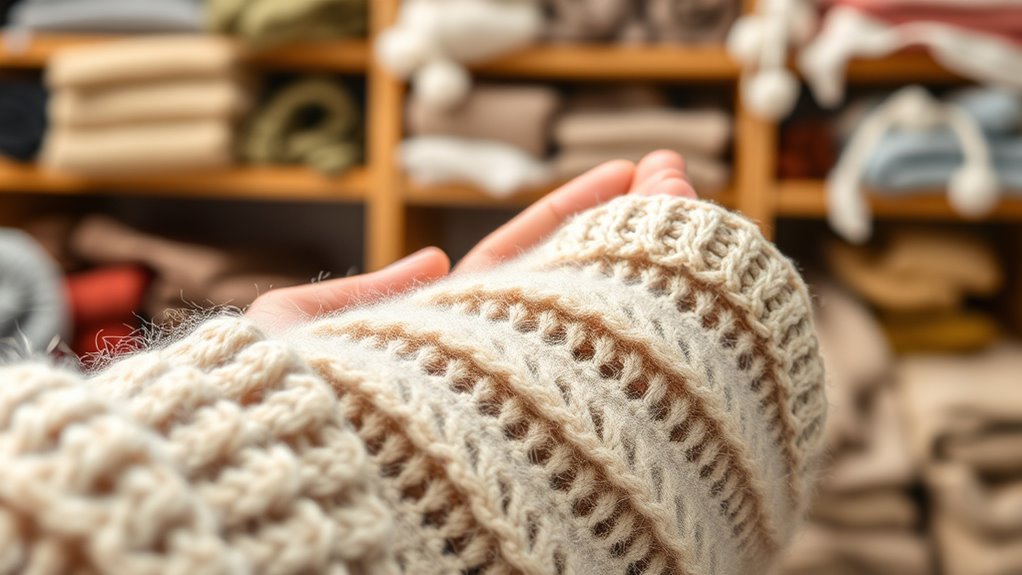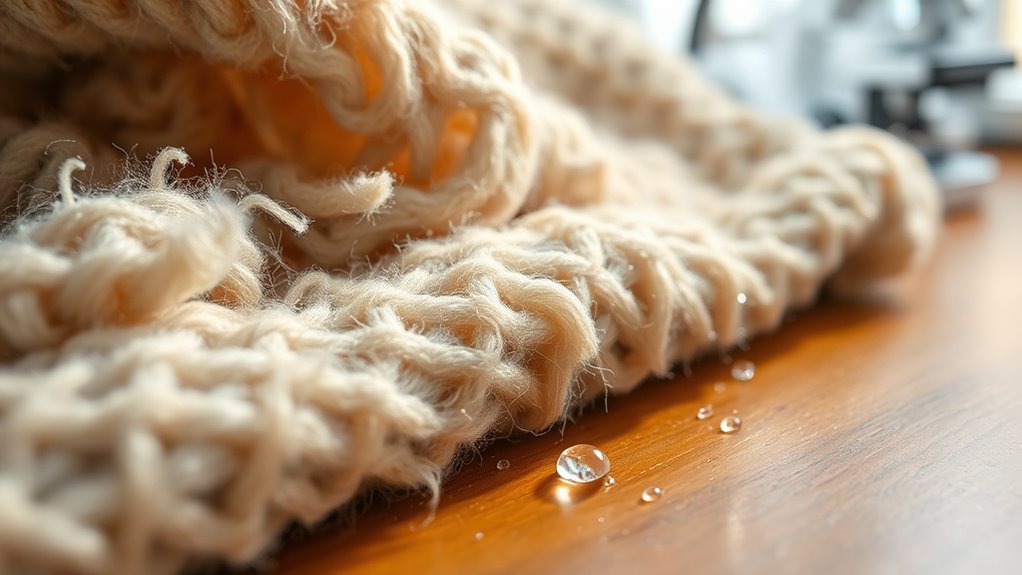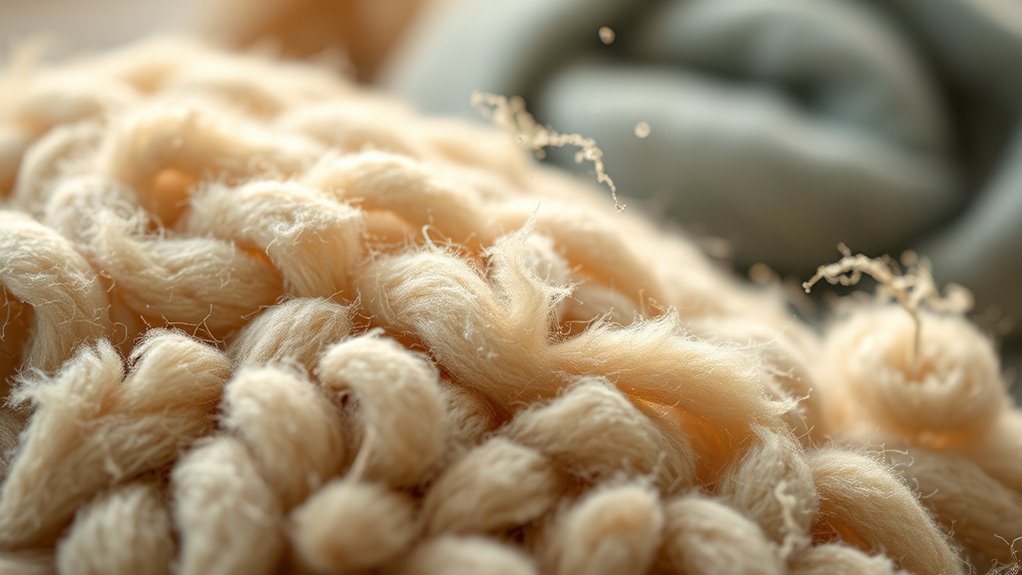Many believe wool always causes allergic reactions, but science shows that’s not true. Most people wear wool without issues, and reactions are often due to sensitivities to lanolin or physical irritation, not allergies. Proper processing and washing can reduce these problems, especially with fine, soft wool like Merino. If you’re sensitive, choosing hypoallergenic options and caring for your wool garments properly can help. To understand more about wool myths and facts, keep exploring the details below.
Key Takeaways
- Wool allergy is rare; many reactions are due to skin irritation or sensitivities, not true allergic responses.
- Lanolin, found in wool, rarely causes allergies; most reactions are caused by physical fiber irritation or contaminants.
- Proper wool processing and washing significantly reduce potential allergens and irritants.
- Scientific studies show wool’s allergenic potential is often overstated; skin reactions usually stem from fiber texture.
- Choosing hypoallergenic or superwashed wool can help sensitive individuals wear wool comfortably.
Debunking the Myth: Wool Always Causes Allergic Reactions

Many people assume that wool always causes allergic reactions, but this isn’t necessarily true. Not everyone reacts to wool, and many individuals wear it without any issues. Wool contains lanolin, which some people are sensitive to, but sensitivity varies widely. An allergic reaction involves the immune system, while some discomfort from wool might stem from skin irritation or sensitivity. These reactions aren’t the same, and not all wool causes problems. High-quality, processed wool often has reduced lanolin, making it less likely to trigger reactions. If you’ve avoided wool out of fear, know that reactions depend on individual sensitivities. Testing or choosing hypoallergenic options can help you determine whether wool suits your skin. Wool’s reputation as an allergen isn’t universal—it varies from person to person. Additionally, skin sensitivities can differ greatly, meaning some individuals may tolerate wool better than others.
Understanding Wool Allergies vs. Wool Sensitivity

Understanding the difference between a wool allergy and wool sensitivity is key to managing your skin reactions effectively. A wool allergy involves an immune response, where your body reacts to proteins in wool, leading to symptoms like hives, swelling, or difficulty breathing. This reaction is more severe and often requires medical attention. Wool sensitivity, on the other hand, is a less intense response, usually causing skin irritation, itching, or redness without activating your immune system fully. You might find that certain wool fabrics irritate your skin but don’t trigger allergic symptoms. Recognizing which condition affects you helps you choose appropriate clothing and treatments. Additionally, inspirational quotes about patience and understanding can provide comfort while navigating these reactions. If you’re unsure whether you have an allergy or sensitivity, consulting a healthcare professional can clarify your specific reaction and guide your choices.
The Role of Lanolin and Its Impact on Allergic Responses

Lanolin, a natural wax found in sheep’s wool, can substantially impact individuals with wool allergies or sensitivities. Many believe lanolin triggers allergic reactions, but research shows true allergic responses to lanolin are rare. Instead, some reactions may stem from impurities or contaminants left after processing. Lanolin’s complex chemical makeup includes fats and other compounds that can irritate sensitive skin, but they don’t necessarily cause allergies. If you notice skin irritation after contact with wool or lanolin-containing products, it might be due to irritation rather than an allergy. However, people with known lanolin allergies should avoid products containing it. Overall, understanding lanolin’s role helps clarify misconceptions, and many individuals tolerate it without issues, making it less of a universal allergen than commonly thought. Additionally, allergy prevalence studies indicate that true lanolin allergies are uncommon among the general population.
How Processing and Treatment Affect Wool’s Allergenicity

The way wool is processed and treated can considerably influence its potential to cause allergic reactions. Proper processing can reduce allergenic proteins and remove irritants that trigger sensitivities. For example, scouring and washing wool thoroughly can eliminate residual lanolin and dirt that may cause skin reactions. Additionally, chemical treatments like bleaching or finishing can alter wool’s surface, impacting allergen presence. These methods can help minimize allergic responses for sensitive individuals. Keep in mind that:
- Extensive washing can lessen allergen levels
- Chemical treatments may neutralize irritants
- Mechanical processing can reduce protein residues
- Proper handling during manufacturing decreases allergen carryover
Understanding allergen reduction techniques can further help in minimizing wool’s allergenic potential.
The Latest Scientific Findings on Wool and Skin Reactions

Recent scientific studies show that wool’s potential to cause allergic responses is often overstated. Skin irritation from wool can result from factors like rough fibers or individual sensitivities, not necessarily allergies. Understanding Narcissistic Traits in individuals can help distinguish between genuine allergic reactions and behavioral responses. Here’s what the latest research reveals about wool and skin reactions, and what it means for your comfort.
Wool and Allergic Responses
Although many believe wool naturally causes allergic reactions, recent scientific studies suggest the relationship isn’t so straightforward. Research indicates that true allergic responses to wool are rare, and symptoms often stem from other factors. Wool contains lanolin, but not everyone reacts to it. Instead, skin sensitivities or irritations may be mistaken for allergies. It’s essential to distinguish between immune responses and irritation caused by rough fibers or cleaning agents. Additionally, advancements in AI-enabled testing are helping to better identify genuine allergies versus irritations.
Key points include:
- Allergic reactions to wool are uncommon in the general population
- Lanolin sensitivity affects only a small subset of people
- Skin irritation may result from fiber texture rather than allergy
- Proper wool processing can reduce potential irritants
Understanding these differences helps you better assess wool’s actual impact on your skin.
Skin Irritation Factors
New scientific findings reveal that skin irritation from wool often results from physical factors rather than allergic responses. Wool fibers can be rough or scratchy, causing mechanical irritation when they come into contact with your skin. Friction and fiber sharpness may lead to redness, itching, or discomfort, especially if your skin is sensitive or dry. Additionally, the natural lanolin in wool can sometimes trap dirt or moisture, worsening irritation for some people. Poor fit or tight clothing made from wool can increase friction and exacerbate skin issues. It’s important to note that these reactions are usually due to the physical texture or fiber properties, not an allergic response. Recognizing the AI vulnerabilities in wool products can help manufacturers develop gentler textiles. Choosing softer wool types or wearing a layer underneath can help minimize irritation and improve your comfort.
Scientific Evidence Summary
Scientific studies have increasingly shown that skin irritation from wool is primarily caused by physical properties rather than true allergies. The rough texture, coarse fibers, and friction can lead to discomfort without an immune response. Recent research highlights that many reactions attributed to wool are due to these mechanical factors rather than allergic sensitivities. Understanding this distinction can help you make better choices and reduce unnecessary avoidance. Key findings include:
- Most skin reactions are caused by fiber texture, not allergens.
- Washing and treating wool can reduce irritation by softening fibers.
- True wool allergies are rare compared to physical irritation.
- Proper clothing fit and fabric choice minimize skin contact issues.
- Recognizing the physical properties of wool can provide better insight into skin reactions.
Understanding these insights helps demystify wool reactions and encourages a more informed approach to wearing wool garments.
Tips for Sensitive Individuals Who Want to Wear Wool

If you want to wear wool but have sensitive skin, start by choosing hypoallergenic wool options designed for delicate skin. Proper care, like gentle washing and avoiding harsh chemicals, can also reduce irritation. These tips can help you enjoy wool comfortably while minimizing allergic reactions. Additionally, exploring specialized apps for tracking skin reactions and symptoms can help identify specific irritants and improve your wool-wearing experience.
Choosing Hypoallergenic Wool Types
Choosing the right hypoallergenic wool can make a big difference if you have sensitive skin. Not all wool is the same, so selecting the appropriate type can reduce irritation and discomfort. Look for wool labeled as hypoallergenic or specifically processed to remove lanolin, which can trigger reactions. Merino wool is often a good choice because its fine fibers are softer and less likely to cause itching. Certified organic wool is processed without harsh chemicals, making it gentler on sensitive skin. Additionally, consider wool that has undergone special treatments, such as superwash or pre-washed varieties, to minimize allergens. Vetted wool options are typically tested for safety and skin compatibility.
- Opt for fine, soft fibers like Merino
- Choose wool labeled hypoallergenic or chemical-free
- Avoid coarse, thick wool types
- Look for pre-washed or superwashed options
Proper Wool Care Techniques
To wear wool comfortably as a sensitive individual, proper care and preparation are essential. Start by washing new wool garments before wearing them to remove residual chemicals and irritants. Use gentle, hypoallergenic detergents and wash in cold water to prevent fiber shrinkage and reduce irritation. Avoid harsh soaps, fabric softeners, and bleach, as these can worsen sensitivities. When drying, lay wool flat or use a low heat setting in the dryer, as high heat can damage fibers. Store wool in a breathable container to prevent moth damage and keep it clean. Regularly airing out your wool clothing can help eliminate odors and moisture buildup. Following these care techniques minimizes irritation and makes wearing wool more comfortable for sensitive individuals.
Frequently Asked Questions
Can Someone Be Allergic to Specific Types of Wool but Not Others?
You might wonder if you’re allergic to certain types of wool but not others. It’s possible, as allergy symptoms can vary depending on the wool’s source and processing. For example, some people react to lanolin in sheep’s wool, while others tolerate it. Checking labels and testing different wool types can help you identify specific triggers. Always consult an allergist for personalized advice and accurate diagnosis.
Are All Wool Products Equally Likely to Trigger Allergic Reactions?
You might think all wool products are equally risky, but that’s not true. Some wool items could trigger your allergy more than others, especially if they contain more allergens like lanolin or are processed differently. You should be cautious with new, untreated wool or heavily processed wool products. Always test a small patch first, because not all wool is created equal, and your allergy response can vary dramatically.
How Do Natural and Synthetic Fibers Compare in Allergy Risk?
When comparing natural and synthetic fibers, you’ll find that natural fibers like wool can sometimes cause allergies due to lanolin or other proteins, but not everyone reacts. Synthetic fibers, on the other hand, tend to be less allergenic since they lack those natural proteins. However, some people develop allergies to chemical finishes or dyes used in synthetic fabrics. Ultimately, your reaction depends on your sensitivity and the specific fiber treatment.
Does Age Influence the Likelihood of Developing a Wool Allergy?
Think of your immune system as a delicate garden, vulnerable to different seasons. Age can influence your wool allergy risk, with children often more sensitive than adults. As you grow, your immune responses may change, making you less prone or more sensitive over time. So, if you’re younger, you might be more likely to develop a wool allergy, but your immune system evolves, potentially reducing this risk as you age.
Are There Any New Treatments or Desensitization Options for Wool Allergies?
You’re wondering if there are new treatments or desensitization options for wool allergies. Currently, research is exploring immunotherapy and allergy shots, but these aren’t widely available yet. Some people find success with allergy desensitization methods or antihistamines to manage symptoms. It’s best to consult an allergist, who can recommend tailored strategies, including potential experimental therapies, to help you better tolerate wool or avoid allergic reactions altogether.
Conclusion
Remember, not all wool causes allergies, and understanding the difference between sensitivity and allergy is key. Recognize that processing can reduce allergens, and that individual reactions vary. Be informed, be cautious, and listen to your skin. Whether you choose wool or not, prioritize your comfort, prioritize your health, and empower yourself with knowledge. With awareness and care, you can enjoy wool’s benefits without fear, embracing comfort, confidence, and clarity in your choices.









